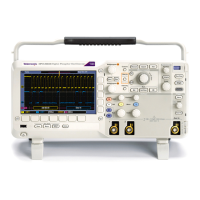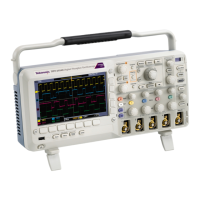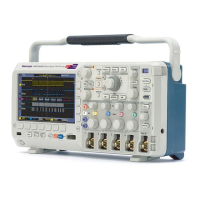Commands Listed in Alphabetical Order
Arguments
<NR1> is the las
t data point that will be transferred, which ranges from 1 to
the record length. If
<NR1> is greater than the record length, then data will be
transferred up to the record length. If both DATa:STARt and DATa:STOP are
greater than the record length, the last data point in the record is returned.
DATa:STARt and DATa:STOP are order independent. When DATa:STOP is less
than DATa:STARt, the values will be swapped internally for the CURVE? query.
If you always want to transfer comple te waveforms, set DATa:STARt to 1 and
DATa:STOP to the maximum record length, or larger.
Examples
DATA:STOP? might return :DATA:S TOP 14900 indicating that 14900 is the last
waveform data point that will be transferred.
DATA:STOP 15000 specifies that the waveform transfer will stop at data point
15000.
DATa:WIDth
Sets or returns the number of bytes per data point in the waveform transferred
using the CURVe command.
Group
Waveform Transfer
Syntax
DATa:WIDth <NR1>
DATa:WIDth?
Related Commands
CURVe
Arguments
<NR1> = 1 specifies that there is 1 byte (8 bits) per point.
<NR1> =2specifies that there are 2 bytes (16 bits) per point. This format is u seful
for AVErage waveforms.
Examples
DATA:WIDTH 1 sets the data width to 1 byte per data point for CURVe data.
DATE
Sets or returns the date the oscilloscope displays.
Group
Miscellaneous
MSO2000B, DPO2000B, MSO2000 and DPO2000 Series Oscilloscopes Programmer Manual 2-133

